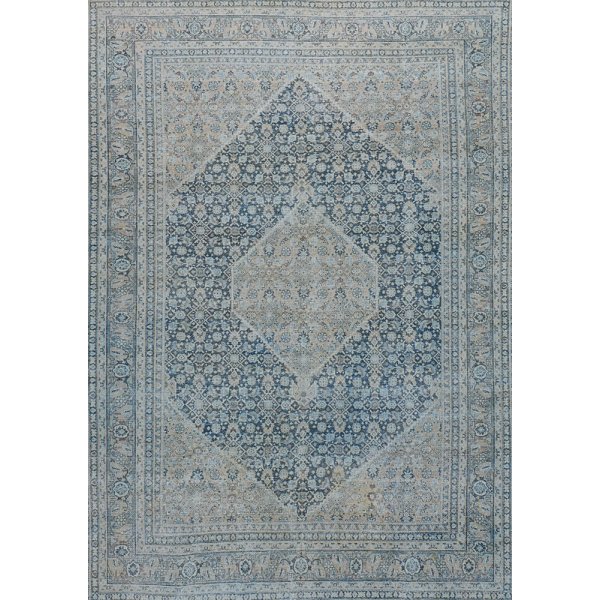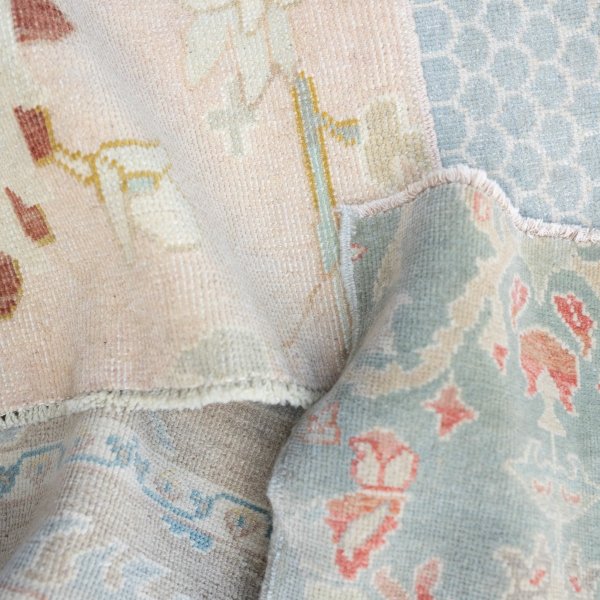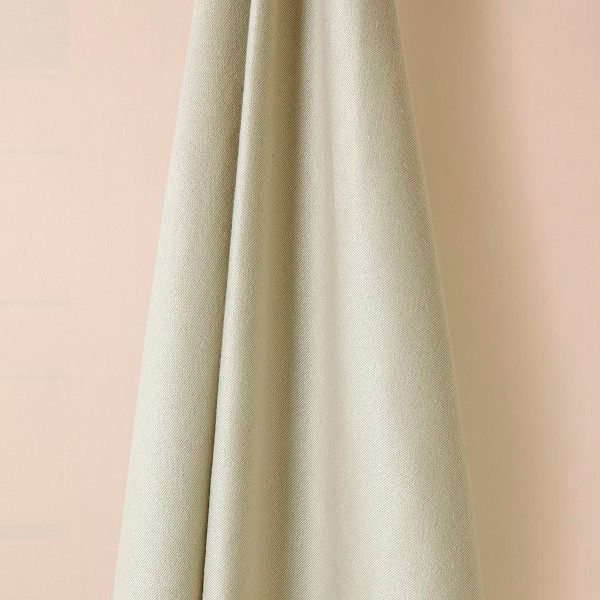Rug Guides: Persian Rugs
Persian rugs were born from the ancient Persian empire, where handweaving was a highly respected art form. Greater Persia encompassed regions belonging to the Caucasus, West Asia, Central Asia and South Asia. Today, it’s most closely associated with Iran. The oldest known carpet from the world is a Persian rug dating back to the 5th century BC. From the outset, Persian rugs were considered extremely luxurious owing to the craftsmanship required to make them and are referenced in Greek texts published as early as 500 BC.
Because of the geographical differences of the region and isolation imposed by them, different styles of Persian rugs emerged from different areas which all developed specific motifs. Historians decipher what regions antique Persian rugs are from based on what symbols appear in the design.
Broadly speaking, there are two types of hand-knotted Persian rugs: city rugs and tribal or nomadic rugs. City rugs are Persian rugs woven in organized workshops where weavers follow a paper blueprint of a design. In tribal or nomadic rugs, the designer and the weaver are the same person. Thus, the weaver creates a Persian rug based off of an image in his or her mind. The result is a design that’s more fluid and loose. Nomadic rugs are generally woven within a home or tent rather than a large scale organized workshop like those found in urban locations. City Persian rugs have a cotton or silk foundation versus the wool foundation of a nomadic Persian rug. Both are equally collectible.

Persian rugs hailing from city centers like Esfahan are floral and intricate, sometimes using no less than 15 colors in a single rug. Those coming from remote rural villages are more symmetrical in design. Antique Gabbehs are simple with a very high pile, which pairs rather seamlessly with today’s modern interiors though they are over 100-years-old. A combination of geometry, symmetry, patterns and symbols can be decoded for meaning. For example, the appearance of a peony in a Persian rug represents power while a pomegranate suggests fertility.
Heriz rugs, otherwise known as Serapis, are some of the most famous rugs from Iran. These persian rugs come from a the major rug-weaving center of Heriz and often have oversized geometric medallions.
Types of Persian rugs include Bakhtiari, Bijar, Eshfahan, Farahan, Gabbeh, Heriz/Serapi, Kashan/Mohtasham, Kerman, Khorassan/Mashad, Persian Kilims, Malayer, Sarouk, Senneh, Sultanabad/Mahal and Tabriz. To read more about the different types of Persian rugs, click here.
What’s so special about Persian rugs?
Persian rugs were born from the ancient Persian empire, where handweaving was a highly respected art form. Greater Persia encompassed regions belonging to the Caucasus, West Asia, Central Asia, and South Asia. Today, it’s most closely associated with Iran. The oldest known carpet from the world is a Persian rug dating back to the 5th century BC. From the outset, Persian rugs were considered extremely luxurious owing to the craftsmanship required to make them and are referenced in Greek texts published as early as 500 BC.
Included Styles
Bakhtiari
Antique Bakhtiari rugs were woven in Zagros Mountains of Iran, and mainly woven by villagers and nomads of the area. The pattern of Bakhtiari rugs is mainly geometric, sometimes semi-geometric, and seldom curvilinear. The designs tend to be very dense, and vibrant colors, such as deep reds, bright blues, navy, greens, brown and beige were commonly used. The most common Bakhtiari design is the garden design, which consists of square, rectangular, diamond, or hexagon compartments filled with floral motives, such as a willow tree, a cypress tree, a grapevine, a vase, or a bird sitting on a branch. Each compartment has a different color and motive from its neighboring compartments.
(Other spelling: Baktiari)
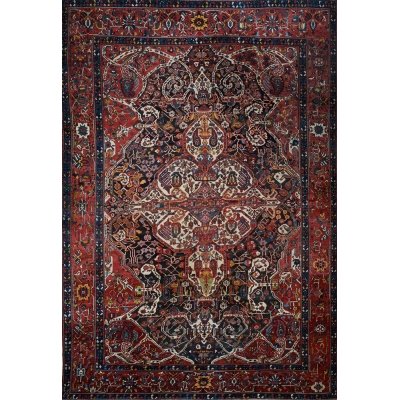
Antique Bakhtiari Rug
- 21197HM
- 12' 6'' x 19' 1''
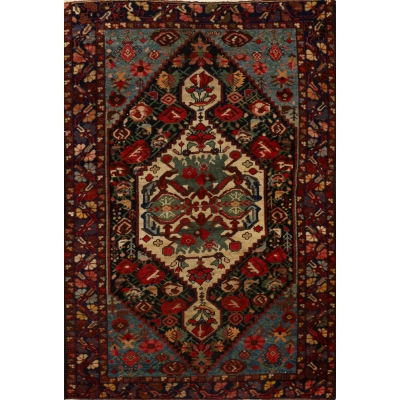
Antique Bakhtiari Rug
- 20366HM
- 4' 3'' x 6' 7''
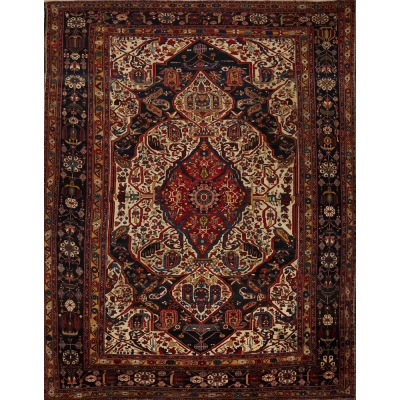
Antique Persian Bakhtiari Rug
- 20011HM
- 14' 9'' x 19' 0''
Bakshayesh
Bakshayesh is a small village in the Iranian Azerbaijan region, located southwest of Heriz. The area is mostly known for its late 19th century carpet production, which includes large-sized rugs with either a Herati or central medallion pattern. Rugs frequently resemble antique Heriz designs and techniques, mainly with a geometric design. The favorite colors of Bakshayesh rug weavers consist of brownish red, light and dark pink, light and dark blue tones, and ivory. Blue is normally used to add contrast.
(Other spelling: Bakhshayesh)
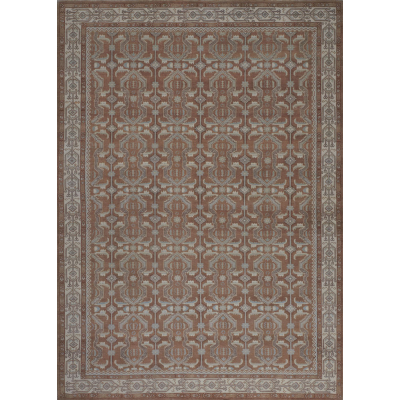
Bakshayesh Rug
- 25258HM
- 10' 9'' x 15' 3''
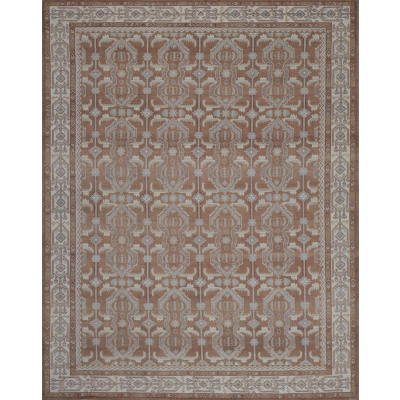
Bakshayesh Rug
- 25255HM
- 10' 0'' x 13' 2''
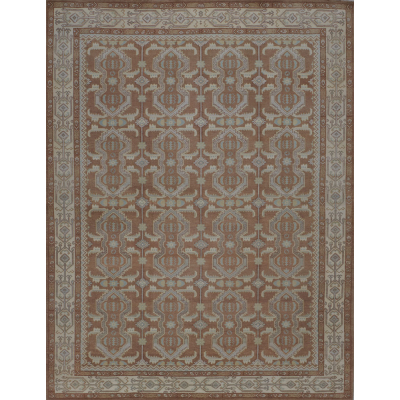
Bakshayesh Rug
- 25157HM
- 9' 0'' x 11' 10''
Bijar
Bijar rugs are mainly woven in the town of Bijar and its surrounding villages. Bijar is located in the province of Kurdistan in northwest of Iran. Bijar rugs are mostly considered village rugs because whether woven in the town of Bijar itself or its surrounding villages, they are woven inside houses rather than workshops. Bijar carpets are usually identified by their weave, rather than the design, since many various designs were used. Bijar weavers beat the weft strands with a hammer against the rows of knot repeatedly until the weave becomes extremely compact. As a result, Bijar rugs are dense, heavy, and exceptionally durable.
(Other spelling: Bidjar)
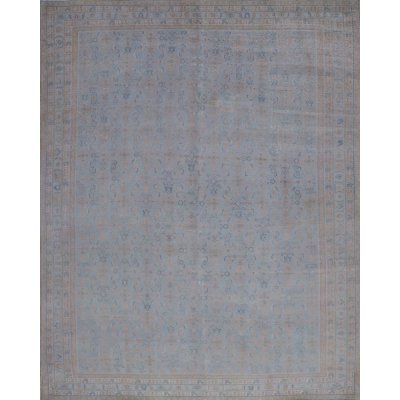
Antique Bijar Rug
- 24921HC
- 9' 8'' x 12' 3''
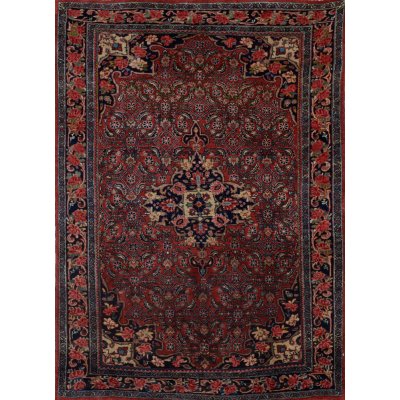
Antique Bijar Rug
- 23565HM
- 3' 7'' x 5' 3''
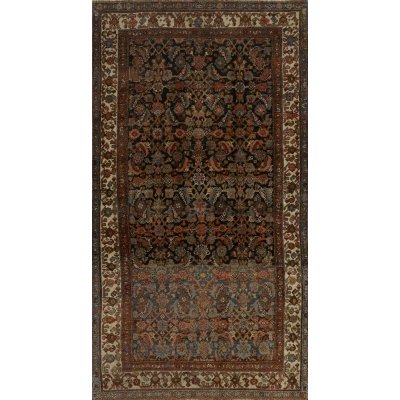
Antique Bijar Rug
- 20417HM
- 4' 7'' x 8' 7''
Esfahan
Esfahan is located in western central Iran. Esfahan rugs have been and still remain very famous worldwide. Since Esfahan has been a capital city of many rulers including Shah Abbas of Safavid Dynasty, many mosques, palaces and other great monuments have been built in Esfahan, especially during the reign of Shah Abbas in the 16th and 17th centuries when Esfahan was a great center of art. These buildings have greatly influenced the rug designs of Esfahan. Some typical designs used in Esfahan rugs are geometric medallions, trees with animals, or pictorials of people and nature, sometimes based on Safavid miniatures.
Many colors are used in Esfahan rugs, seldom less than 15 in one rug. Most commonly colors, such as turquoise, navy, red, beige, and pale mushroom. Another characteristic of Esfahan rugs is the very specific terra cotta red color, that is frequently used either in the field, border or accents of the carpet. This unique crimson-colored dye is derived from a small scale insect, called Cochineal.
(Other spelling: Isfahan)
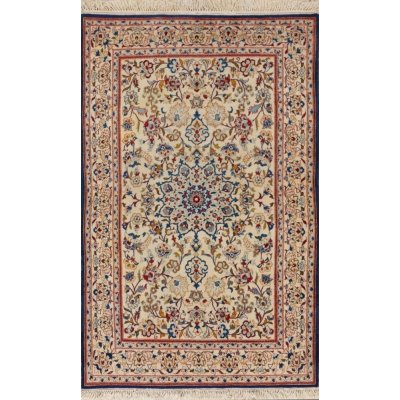
Semi-Antique Persian Esfahan Rug
- 18130HC
- 3' 4'' x 5' 4''
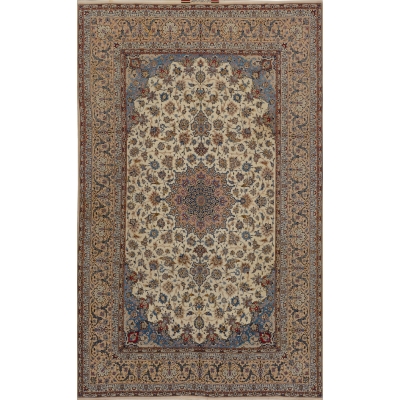
Semi-Antique Persian Esfahan Rug
- 16852HM
- 7' 0'' x 11' 1''
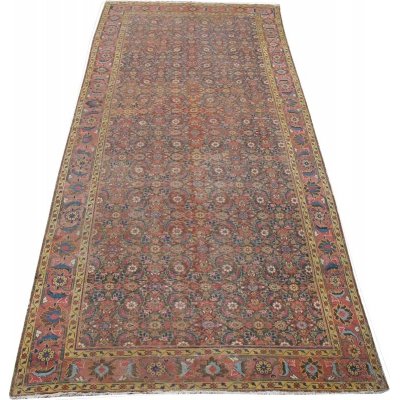
Antique Persian Esfahan Rug
- 15714HM
- 7' 1'' x 16' 10''
Farahan
Farahan is a village located in west central Iran, north of the city of Arak, and is known for its finely knotted late 19th century rugs. Most Farahan rugs have a geometric pattern, although some curvilinear rugs are woven in the region as well. These high quality rugs can be divided into two main types. The first type is characterized by an all-over or endless-repeat pattern with motives such as the herati or boteh design. Herati, being the most popular motives, has many variations and the boteh motives are usually woven inside hexagon-shape panels.
The second type is characterized by its medallion layout and has a classical Persian design, so-called Sarouk-Farahans. The medallions can be large hexagon, diamond, or oval shapes with large ornaments. Two common motives used in the field of these rugs are the herati and gul hannai design.
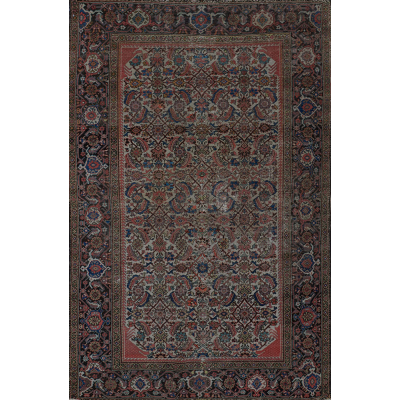
Antique Farahan Rug
- 22414HM
- 4' 0'' x 6' 2''
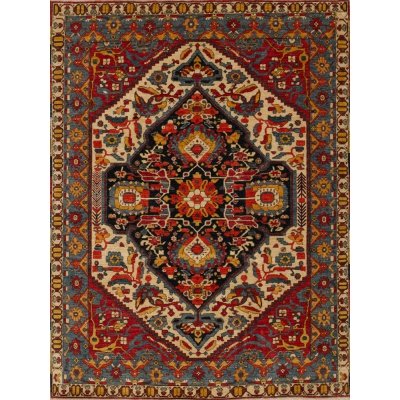
Farahan Rug
- 20201HM
- 5' 0'' x 6' 7''
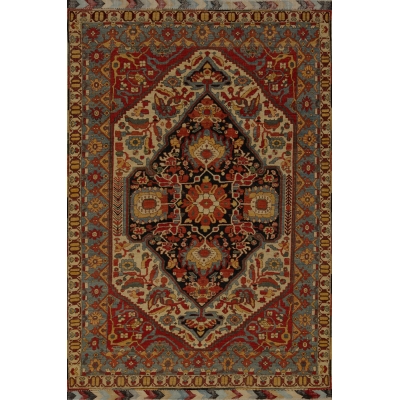
Farahan Rug
- 19626HM
- 4' 11'' x 7' 5''
Gabbeh
Antique Gabbehs are tribal and rural Persian rugs with a simple geometric pattern and a very high pile. The rugs are made by nomads of the Fars province, in the area of the famous city Shiraz.
Although Antique Gabbehs are not much older than 100 years, the existence of Persian Gabbehs was recorded during Shah Tahmasp, who ruled Iran for 53 years and was the second monarch of the Safavid dynasty (1502-1736). He had ordered the use of Gabbeh rugs along other rugs to welcome and honor King Homayun of India, who took refuge to Iran.
Gabbehs like many other Persian rugs are made with local handspun wool and vegetable dye. Simplified human, animal, and tree motives are usually utilized by Gabbeh weavers, who use their imagination and the environment around them to weave such designs. Although tribal, the abstract and cubist designs of Persian Gabbehs look very modern and match the interiors of today's homes.
(Other spelling: Gabeh).
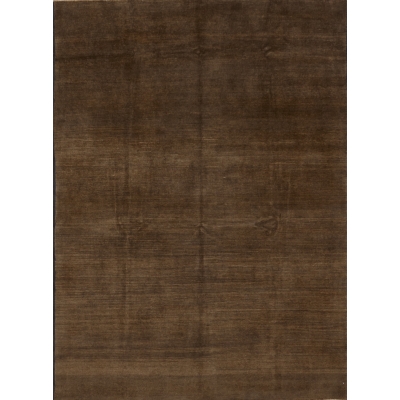
Gabbeh Rug
- 18925HM
- 6' 5'' x 8' 7''
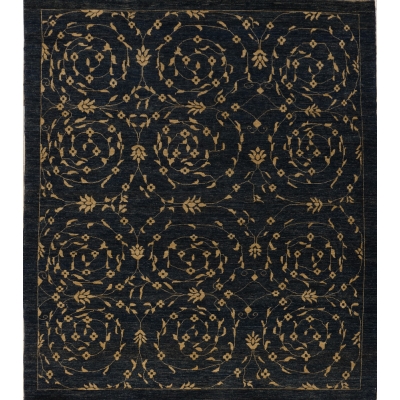
Gabbeh Rug
- 18920HM
- 8' 0'' x 9' 4''
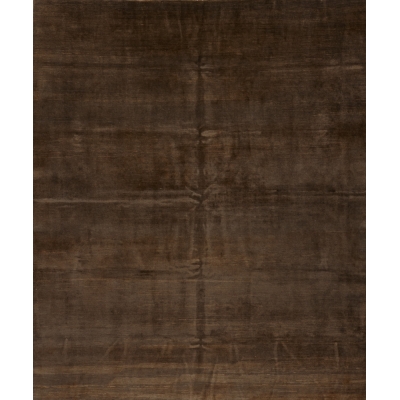
Gabbeh Rug
- 18904HM
- 8' 3'' x 9' 9''
Heriz / Serapi
Heriz rugs are one of the most famous rugs from Iran, because of their very unique and distinguishable style. Heriz is a city located in northwestern Iran, near the city of Tabriz, which is a major rug-weaving center in Iran. Most often, Heriz rugs have oversized geometric medallions, that are crisply delineated against a rich red, rust or dark blue field.
The pattern is almost always geometric, although some Heriz rugs have an all-over layout often together with geometric floral motives and less frequently curvilinear floral motives. Since the Heriz region is not too far from the Caucasus, many Heriz carpets have similar colors and drawings to Caucasian rugs. The most common colors are brownish red, light and dark pink, light and dark blue, greens, yellows and ivory. Blue and ivory are normally added to increase contrast.
Serapi is a trade name given to better quality Heriz rugs thought to have been woven before 1900. In the United States, the highest quality of Heriz rugs are called Serapi. The name Serapi originates from the village of Serab. It is also located in northwestern Iran and has adopted some characteristics of Caucasian carpets.
(Other spelling: Hariz)
Where are Heriz rugs from?
Heriz rugs are one of the most famous rugs from Iran, because of their very unique and distinguishable style. Heriz is a city located in northwestern Iran, near the city of Tabriz, which is a major rug-weaving center in Iran.
What is a Heriz style rug?
Most often, Heriz rugs have oversized geometric medallions, that are crisply delineated against a rich red, rust, or dark blue field.
What is a Serapi rug?
Serapi is a trade name given to better quality Heriz rugs thought to have been woven before 1900. In the United States, the highest quality Heriz rugs are called Serapi.
Where are Serapi rugs from?
The name Serapi originates from the village of Serab. It is also located in northwestern Iran and has adopted some characteristics of Caucasian carpets.
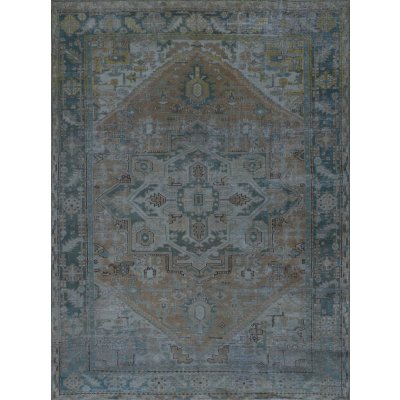
Vintage Heriz Rug
- 25239HM
- 7' 11'' x 10' 7''
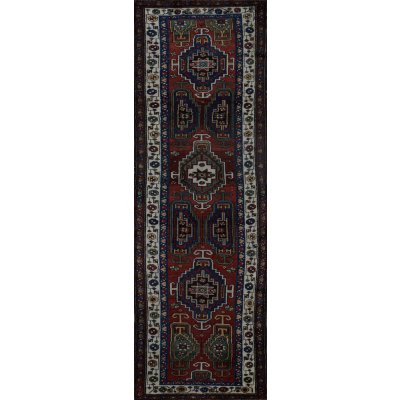
Antique Persian Heriz Rug
- 25123HM
- 3' 8'' x 10' 0''
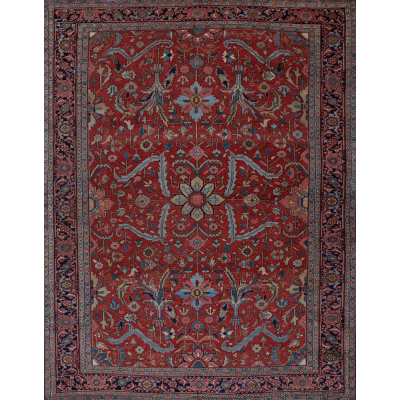
Antique Heriz Rug
- 24835HC
- 9' 5'' x 12' 5''
Kashan / Mohtasham
Antique Kashan carpets are among the finest Persian rugs. They are woven in workshops of the city of Kashan, in north central Iran. Kashan was a hub of silk production since the Safavid dynasty, and has created some of the highest quality Persian silk rugs. During the latter part of the 19th century, weavers also began to produce high quality wool rugs and carpets, continuing the high standards of technique and design of the Safavid era.
Among the best Kashan carpets are Mohtasham rugs. They are commonly referred to Kashan-Mohtasham rugs and They frequently have deep and rich color palette and a traditional navy medallion, although all-over designs are rare and not uncommon.
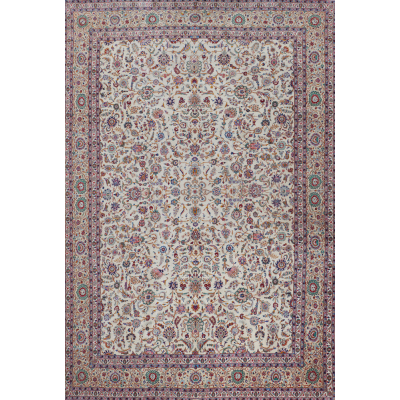
Antique Persian Tabriz - Kashan Rug
- 24045HM
- 14' 0'' x 22' 0''
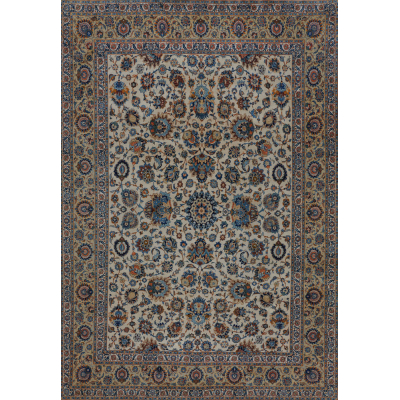
Semi-Antique Kashan Rug
- 22814HC
- 12' 0'' x 17' 8''
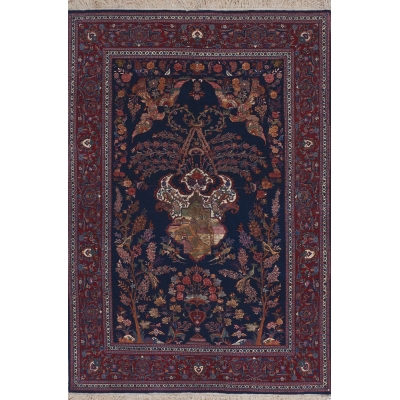
Antique Kashan Rug
- 21594HM
- 4' 8'' x 6' 9''
Kerman
Kerman is an ancient city, with an incredible history going back over a thousand years. Marco Polo was one of the first westerners to view Kerman rugs. The city is located in the central south-eastern section of Iran, in the province that bears its name. Kerman rugs and carpets are perhaps one of the most recognizable within the antique Persian rug category. A typical pattern for Kerman rugs and carpets is a floral or architectural theme in the main border with a central medallion in the field. Other patterns include the finer Kerman Lavar style with garden, tree-of-life, vase, and all-over mille fleur designs, or the many pictorials which tell the story of a significant figure or event in history. The vase design carpets originated during the Safavid dynasty, and are among the greatest masterpieces of Persian weaving.
(Other spelling: Kirman)
Where are Kerman rugs from?
Kerman is an ancient city, with an incredible history going back over a thousand years. Marco Polo was one of the first westerners to view Kerman rugs. The city is located in the central south-eastern section of Iran, in the province that bears its name.
The city is located in the central south-eastern section of Iran, in the province that bears its name. Kerman rugs and carpets are perhaps one of the most recognizable within the antique Persian rug category.
How do I identify a Kerman rug?
A typical pattern for Kerman rugs and carpets is a floral or architectural theme in the main border with a central medallion in the field. Other patterns include the finer Kerman Lavar style with garden, tree-of-life, vase, and all-over mille fleur designs, or the many pictorials which tell the story of a significant figure or event in history.
The vase design carpets originated during the Safavid dynasty, and are among the greatest masterpieces of Persian weaving.
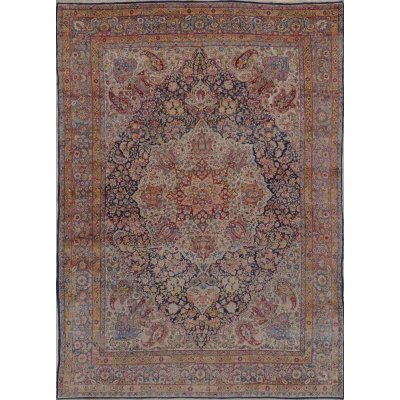
Antique Persian Kerman Rug
- 18142HC
- 8' 10'' x 12' 8''
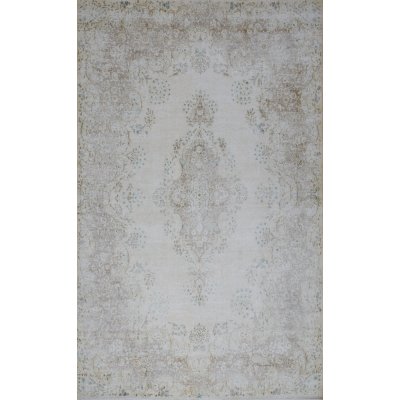
Antique Kerman Rug
- 23999HM
- 9' 6'' x 16' 0''
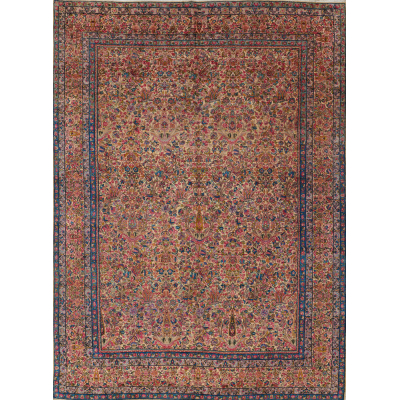
Antique Kerman Rug
- 23446HM
- 8' 9'' x 12' 1''
Khorassan / Mashad
Khorassan rugs and carpets are famous for their fine rugs dating back to the Timurid empire in the late middle ages. The region lies in northeastern Iran, and its capital city of Mashad is one of the most important rug weaving centers in the industry. Khorassan rugs are famous for their vivid purplish red, crimson, or vivid red background. The natural red color is obtained from a plant with red granule that only grows in the Khorassan region. Other general colors that are used in Khorassan and Mashad rugs and carpets are vivid red and purple tones, blue tones, navy, brown tones and a variety of green colors. It is also common for some Khorassan rugs and carpets to have a softer and more decorative coloration. There are many different designs, ranging from all-over patterns to arabesque medallions with corner-pieces, that are particularly noteworthy. The Herati border is also frequently applied. Another significant characteristic of Khorassan and Mashad rugs is the very soft and lustrous wool used in the production.
(Other spelling: Korassan)
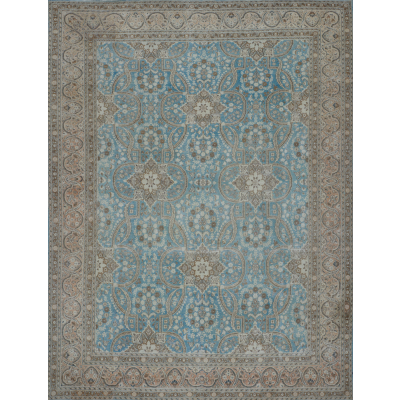
Antique Mashad Rug
- 24540HC
- 9' 8'' x 12' 9''
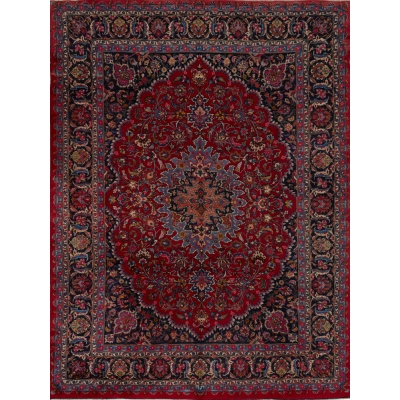
Semi-Antique Oriental Mashad Rug
- 12432HC
- 9' 3'' x 12' 1''
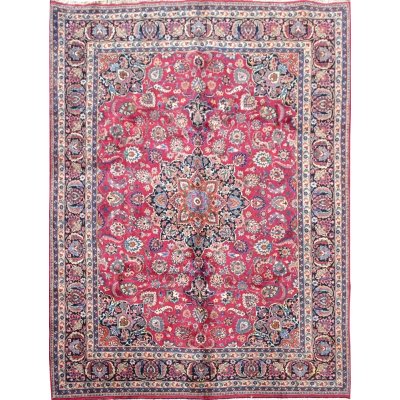
Antique Oriental Mashad Rug
- 12215HM
- 10' 1'' x 12' 11''
Khotan
Antique Khotan rugs and carpets were produced in the oasis town of Eastern Turkestan, today part of the Xinjiang region in Western China. This area has had a steady production of carpets since the 17th century, peaking in the 18th and 19th centuries. Khotan rugs and carpets tend to be geometric with abstract drawings with color palettes of rich colors to soft pastels.
(Other spelling: Kotan)
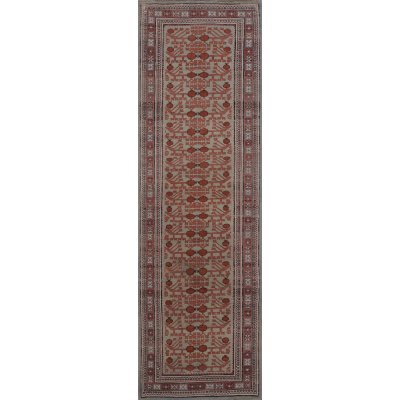
Khotan Rug
- 25267HM
- 3' 0'' x 10' 2''
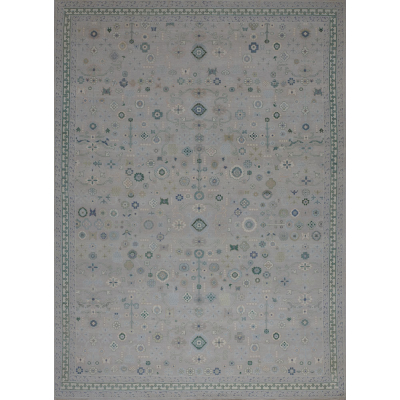
Khotan Rug
- 25263HM
- 10' 11'' x 15' 3''
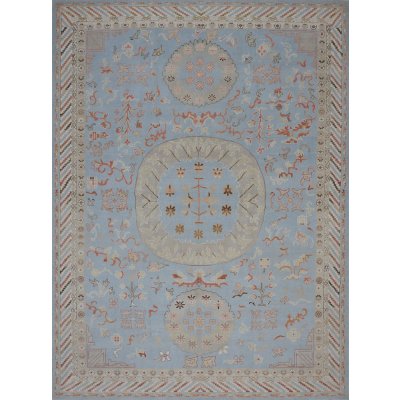
Khotan Rug
- 25261HM
- 8' 4'' x 11' 8''
Malayer
Antique Malayer rugs were woven in the small town of Malayer, located south of Hamedan on the road to Arak. The location in relation to these towns is significant, since Malayer rugs exhibit characteristics of both Hamedan and Sarouk rugs and carpets. The designs range from diamond or hexagon shaped medallions to all-over patterns, such as the classic Herati pattern. Although Malayer rugs were produced from classical Persian sources, they tend to be fairly geometric and abstract in their renderings. Most Malayer rugs and carpets are single-wefted, resulting with white cotton warps being visible on the back of the rug. The soft coloration with occasional dark blues and reds, make Malayer rugs beautiful decorative pieces for elegant settings.
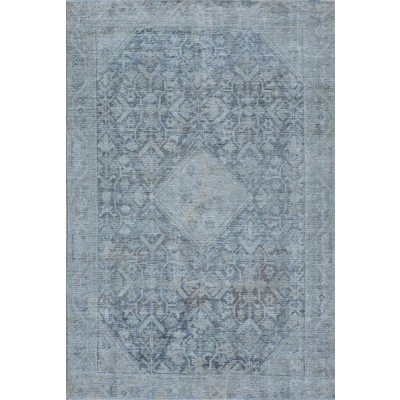
Vintage Malayer Rug
- 25292HM
- 4' 1'' x 6' 5''
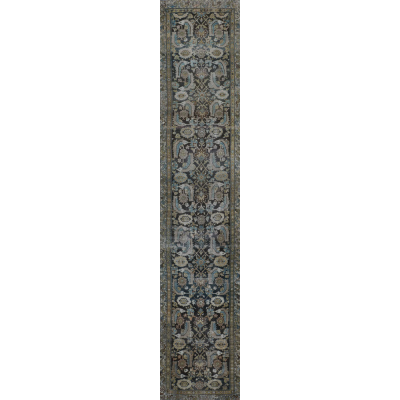
Vintage Malayer Rug
- 25291HM
- 3' 5'' x 18' 6''
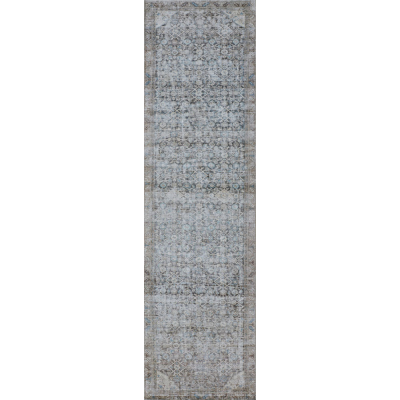
Vintage Malayer Rug
- 25290HM
- 3' 6'' x 13' 8''
Sarouk
Sarouk is a name of a village situated about 25 miles north of Arak (Sultanabad). This region became one of the most active regions of carpet weaving in the late 19th Century through the early 20th Century. The city's most famous designer was named Farahan. To be able to compete with Kashan in rug commerce, Farahan designed rugs with center medallion motives. Today, these carpets are referred to as Antique 19th century Farahan Sarouks.
In the 1920s and 1930s a well-known rug dealer in New York thought that Americans would buy rose-field carpets with blue borders and detached floral motives. During that period, a vast number of Sarouks with rose-fields and all over floral patterns were woven and exported to the American market. However, the natural dyed rose color did not stand up to the alkaline bath to which new rugs in Arak were subjected in the finishing process. The rose color faded radically. But instead of changing the finishing process or changing the composition of the dyes to stand up to alkali, New York merchants "solved" the problem by arming their staffs with synthetic dyes and little paint brushes with which they painted back in the rose-color in the entire fields of thousands and thousands of rugs and carpets over a period of 20 years. Today, Antique Sarouk rugs and carpets are among the most luxurious classically derived, room-sized Persian carpets.
What is an American Sarouk rug?
In the 1920s and 1930s, a well-known rug dealer in New York thought that Americans would buy rose-field carpets with blue borders and detached floral motives. During that period, a vast number of Sarouks with rose fields and all-over floral patterns were woven and exported to the American market. However, the naturally dyed rose color did not stand up to the alkaline bath to which new rugs in Arak were subjected in the finishing process.
The rose color faded radically. But instead of changing the finishing process or changing the composition of the dyes to stand up to alkali, New York merchants "solved" the problem by arming their staffs with synthetic dyes and little paint brushes with which they painted back in the rose-color in the entire fields of thousands and thousands of rugs and carpets over a period of 20 years.
Today, Antique Sarouk rugs and carpets are among the most luxurious classically derived, room-sized Persian carpets.
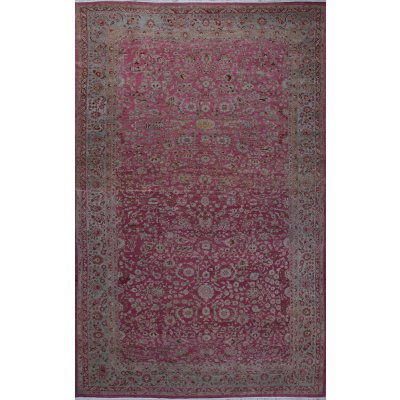
Antique Sarouk Rug
- 24956HM
- 12' 4'' x 20' 2''
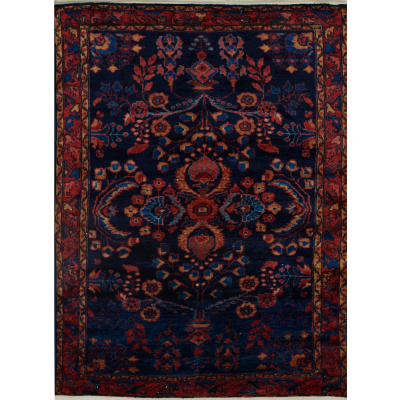
Antique Lilihan Sarouk Rug
- 24559HC
- 3' 5'' x 4' 5''
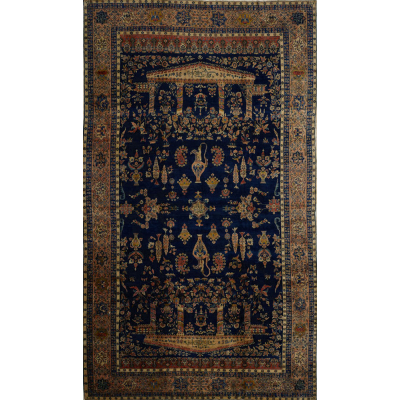
Antique Persian Sarouk Rug
- 20108HM
- 12' 0'' x 20' 5''
Senneh
Antique Senneh rugs and carpets, produced in Northwest Iran, are highly valued and prized for their fine, delicate design and weaving technique. They are among the "thinnest" of all Persian rugs, and come in a range of medallion or all-over design patterns with small scale Herati repeats. Being single wefted, they tend to wear less than other comparable rugs produced in surrounding villages. Senneh rugs and carpets always display a meticulous, geometric drawing that corresponds to the precision of the weave. The colors tend to vary, and range for rich to softer color shades.
Some of the very finest examples of Senneh rugs and carpets were knotted on silk foundations, usually dyed in a variety of shades to give their fringes a rainbow-like appearance. Most Senneh rugs were produced in smaller or runner sizes and make excellent decorative accents rugs, although some were produced in room-sized carpets as well.
(Other spelling: Seneh)
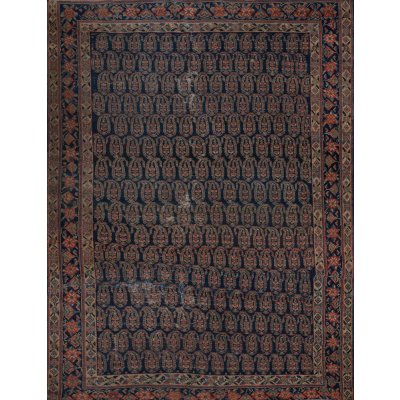
Antique Senneh Rug
- 24927HM
- 4' 0'' x 5' 4''
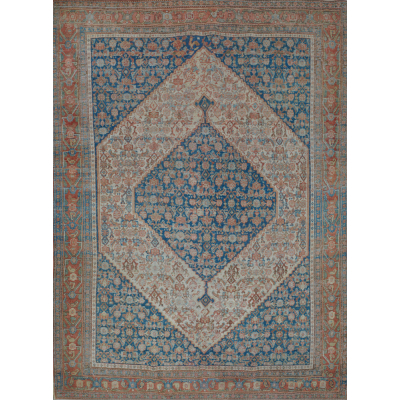
Antique Senneh Rug
- 24571HC
- 4' 6'' x 6' 0''
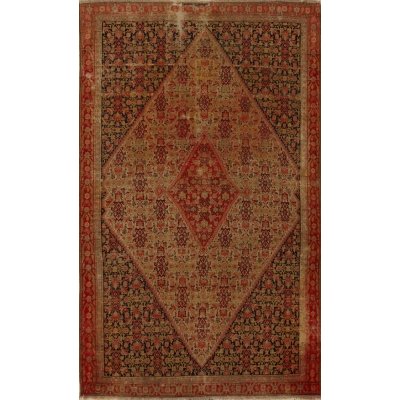
Antique Persian Worn Senneh Rug
- 19489HM
- 4' 1'' x 6' 9''
Sultanabad / Mahal
Sultanabad and Mahal rugs are produced in the area around the city of Arak, which has a history of rug weaving dating back to the mid-17th Century. The city was originally founded in 1808 as Sultanabad and later in 1930 was renamed to the city of Arak. The city is older than these dates might indicate. The term Sultanabad has come to distinguish the oldest and highest quality Mahal carpets, also known as Ziegler Mahals, named after a British firm in Manchester, founded in1883, that supervised the production for exports to the West. Most Sultanabad and Mahal rugs have bold and floral designs, whether they utilize classical medallion or overall designs of vine scrolls and palmettes. Traditionally, dark reds and blues were common colors with highlights of soft green and ivory.
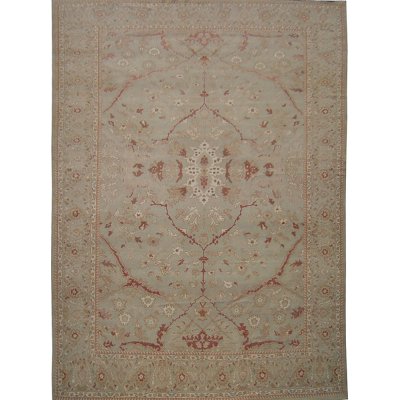
Sultanabad Rug
- 16712HM
- 10' 10'' x 14' 11''
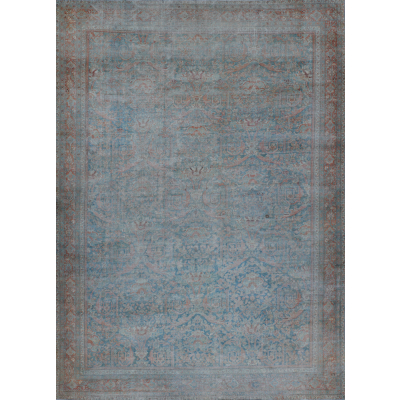
Vintage Sultanabad Rug
- 24701HM
- 12' 0'' x 16' 9''
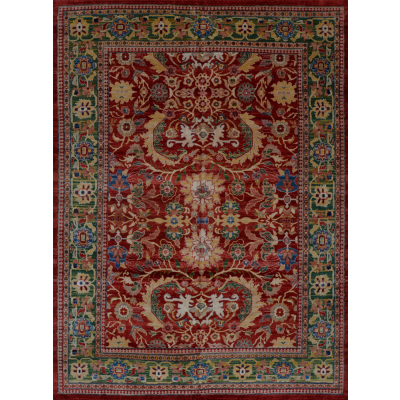
Mahal Rug
- 24596HM
- 8' 9'' x 11' 9''
Tabriz
Tabriz is Iran's second oldest city, and was the earliest capital of the Safavid dynasty. The city has been the foremost Persian rug production town since the 15th Century and the center of the world's weaving community since the 1800's. Tabriz rug weavers are among the most skilled producers of quality rugs with the highest technical standards and the most varied repertoire. It is also worth mentioning that Tabriz rugs are the most traded rugs in the world. The designs are the most diverse designs of Persian carpets, and weavers used many different motifs, from classic medallion to all-over patterns, in every color imaginable, from brilliant rich tones to soft pastels. Tabriz rugs are of great interest to interior designers who look for fine decorative Persian rugs and carpets of the highest value.
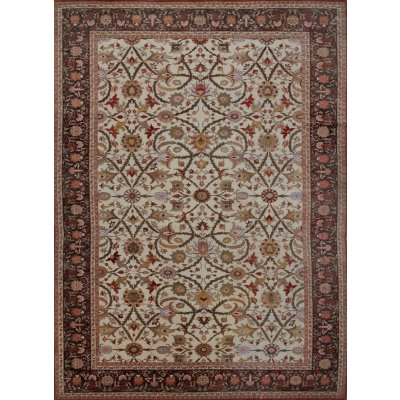
Tabriz Rug
- 24999HC
- 12' 4'' x 17' 6''
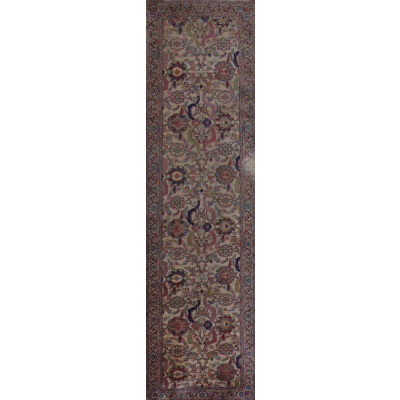
Antique Tabriz Rug
- 24895HC
- 5' 1'' x 19' 11''
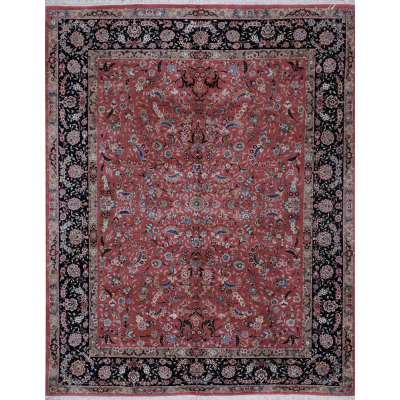
Tabriz Rug
- 24840HC
- 8' 1'' x 9' 10''
You cart is empty. Shop now
